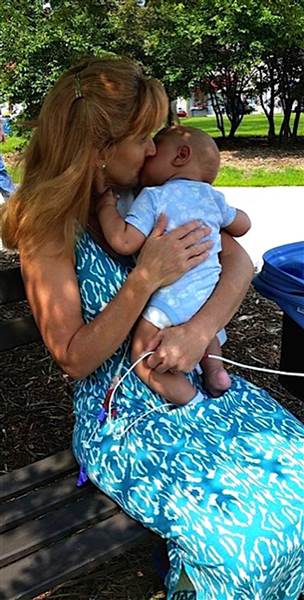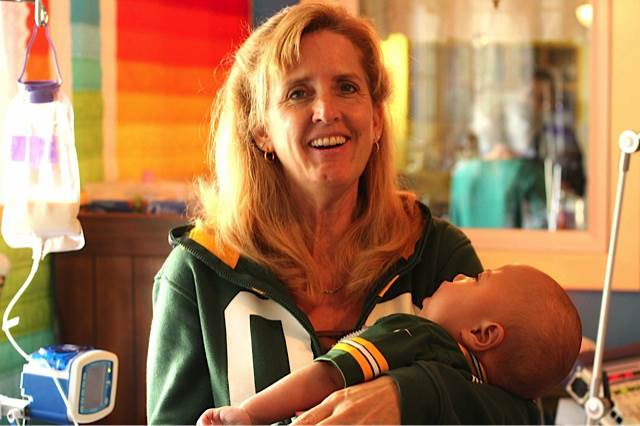Cori Salchert calls the home she shares with her husband, Mark, a «house of hope.» A former perinatal bereavement nurse with eight biological children, Salchert began adopting what she calls «hospice babies» —babies with life-limiting or terminal diagnoses — in 2012.
Salchert says these babies come from families who find it difficult to deal with the condition their child was born with. Many step away because they can’t bear to witness the end of their child’s life.
The first of the Salcherts’ hospice babies, Emmalynn, lived for 50 days before dying while cradled in Cori’s arms. Since then, the Salcherts and their children have made it their mission to care for as many babies that need it.
The family first told their story to the Sheboygan Press earlier this month. Here, Cori Salchert tells TODAY’s Terri Peters about the road that led her to shelter these sick children in their final days.
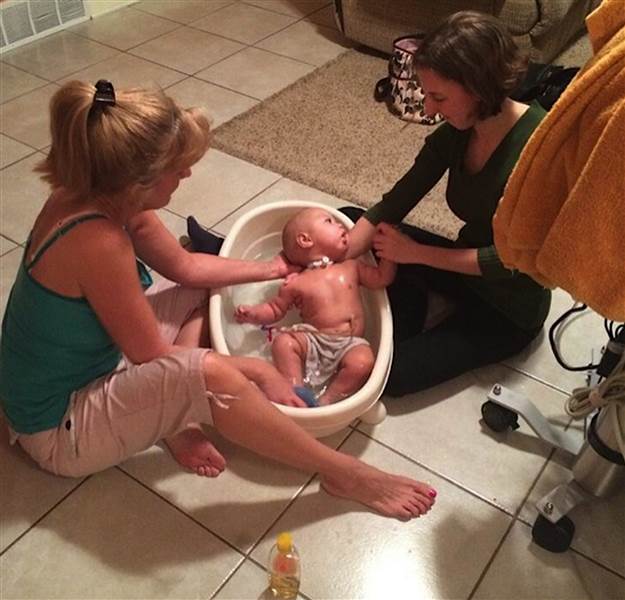 Salchert’s daughter, Johanna, 22, helps her bathe Charlie.
Salchert’s daughter, Johanna, 22, helps her bathe Charlie.
As I sit here at the dining room table, the whirring sound of Charlie’s ventilator and oxygen condenser in the background, I feel I should go back to where this passion for kids began.
Because, overall, a smidge of our story is sad — yes —but if that’s all that’s seen, 95 percent of the joy has been missed.
When my younger sister, Amie, was an infant, she contracted spinal meningitis. After the high fevers from the infection destroyed quite a bit of her brain function, leaving her mentally and physical handicapped, she went to live in a children’s home for kids who were severely impaired like she was.
When Amie was eleven, she wandered out of an unlocked door at this children’s home and drowned in a pond on a nearby golf course. She was most likely alone and struggling to understand why she couldn’t breathe and there was no one there to help her.
Throughout my life, I struggled with the question, «Where was God when my sister needed Him most?»
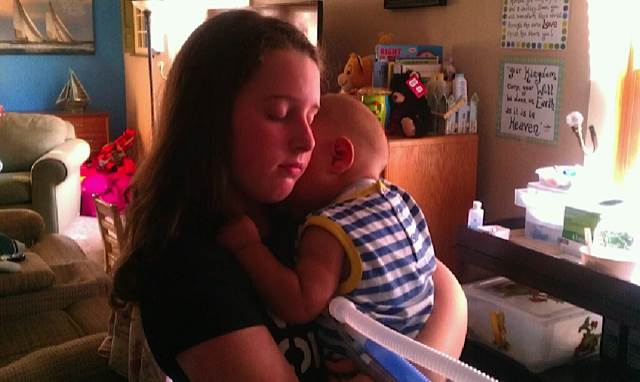 Salchert’s daughter, Emily, 14, holds Charlie.
Salchert’s daughter, Emily, 14, holds Charlie.
In my adult years, I heard a song lyric: «It may be unfulfilled, it may be unrestored, but anything that’s shattered that’s laid before the Lord will not be unredeemed.»
It was this promise that changed my prayers. Instead of asking God over and over why things had been the way they were, I laid down the hurt and disillusion before God and said, «Here, you take this and redeem it.»
And He did — in ways beyond fathoming.
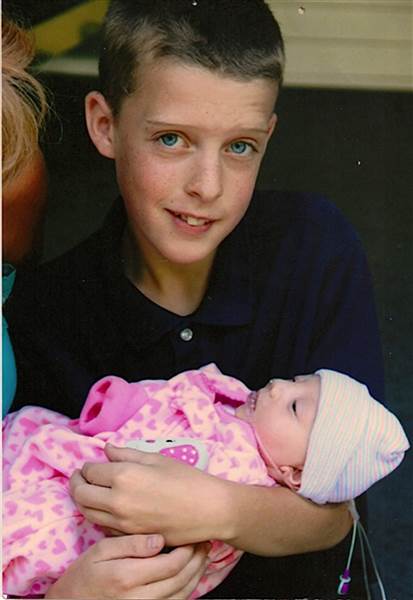 Salchert’s son, Andrew, now 16, with Emmalynn.
Salchert’s son, Andrew, now 16, with Emmalynn.
Over my years working as a registered nurse, I came into contact with just about every kind of patient. My favorites were hospice care, and working with maternity patients and newborns.
When I started working more in the maternity field, I thought I’d left hospice behind me, until I realized that there were many more than I ever realized who come to the maternity floor to have a baby and instead leave with aching and empty arms because their child died in the womb or shortly after birth.
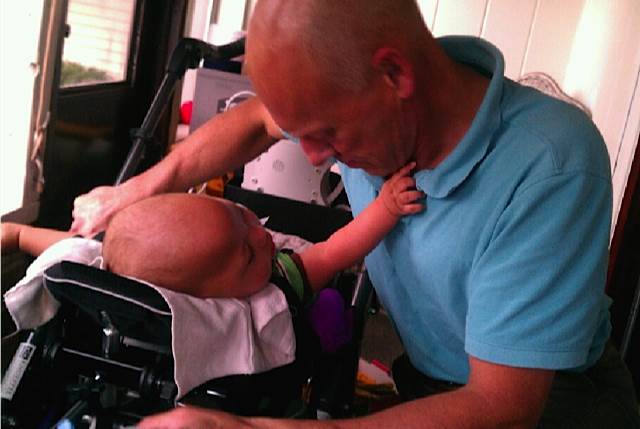 Salchert’s husband, Mark, assists Charlie.
Salchert’s husband, Mark, assists Charlie.
I found myself drawn to helping these families. Where many obstetrics nurses prefer not to work with dying babies, I saw a need to make the hospital experiences of these women less traumatic — not by fixing what was broken — but by handling them with care instead of rushing out of the room because their grief made me uncomfortable.
I later began the Hope After Loss Organization in Sheboygan. It’s an organization designed to offer hope to families whose babies had died.
Then, about five years ago, my own health hit a crisis point. I was battling several autoimmune diseases, and required several surgeries to attempt to repair the damage done to my digestive organs. I was suffering, bedridden, unable to work, and again found myself crying out to God, asking, «Well, how in the world are you going to redeem this one?»
But in August of 2012, we received a call asking if we would be willing to take in a two-week-old baby girl who was nameless and had no one to care for her.
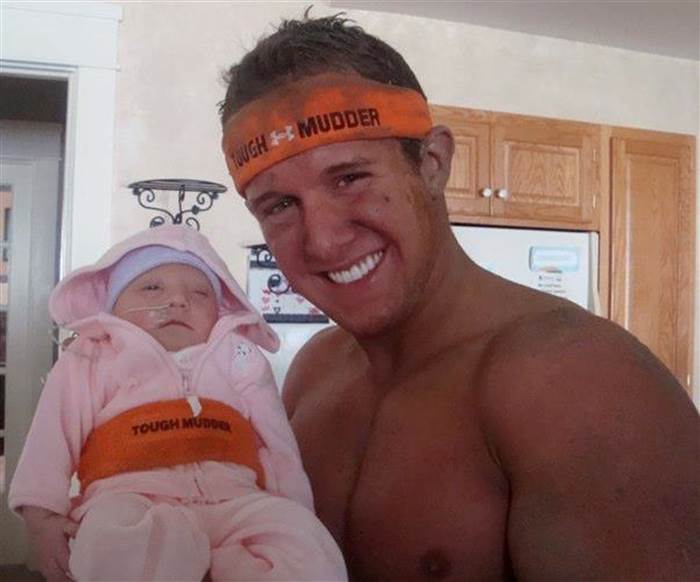 Salchert’s son, Jonathan, 25, with Emmalynn.
Salchert’s son, Jonathan, 25, with Emmalynn.
The baby’s prognosis was grim, as she was born without the right or left hemisphere of her brain, and doctors said there was no hope for her. I was told that she was in a vegetative state — unable to see or hear, and only responding to painful stimuli.
Taking all of that information in stride, we left to bring Emmalynn home, having been given the privilege to choose a meaningful name for her and allowed the priceless gift of being her family.
She could have died in the hospital, wrapped in a blanket and set to the side because she was being sustained with a feeding pump. But we brought this beautiful baby home to live, and live she did.
Emmalynn lived more in 50 days than a number of folks do in a lifetime. She had not had a family, and now she was suddenly the youngest sibling of nine. We held her constantly and took her everywhere with us.
There came an evening when I knew Emmalynn was beginning to fade. The whole family was home and got to hold her and kiss her. My husband tucked her close with her little head under his chin and sang to her. Eventually, most of the family began to drift off and head to bed, but my daughter, Charity, and I stayed awake with her.
I was snuggling Emmalynn into my furry, warm bathrobe, holding her on my chest and singing ‘Jesus Loves Me’ to her, when it occurred to me that I had not heard her breathe for a few minutes. I leaned her back to look at her, and saw that this beautiful creature was gone. She’d left this world hearing my heartbeat. She didn’t suffer, she wasn’t in pain, and she most certainly wasn’t alone. It was painful initially. Gradually we were able to see the opportunity to hold her through this life and as she entered the next solely as a gift.
Emmalynn had left her tiny impression on our lives and, while we were grieving her loss, we eventually began to heal and consider taking in another baby.
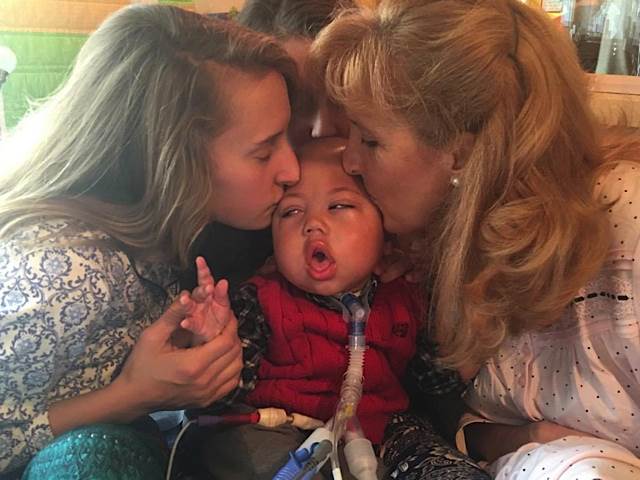 Salchert and daughter, Mary Elizabeth, 18, kiss Charlie.
Salchert and daughter, Mary Elizabeth, 18, kiss Charlie.
In October of 2014, we took in four-month-old Charlie. Charlie has a life-limiting diagnosis, but is not necessarily considered terminal. However, children with this type of brain damage typically die by two years of age. Charlie is already on life-support, and has been resuscitated at least ten times in the past year. He now has an altered plan of care, and should he code again, we will not resort to doing compressions and using an AED machine — this time, we will let him go.
I find my own breath catching in my chest at the number of times we’ve helped resuscitate this little guy. I cannot stand the thought of suffocating, and to know that having to draw all of his breaths through a tiny straw is Charlie’s reality…it’s difficult for me.
As in Emmalynn’s case, we do everything we can to love Charlie, and we take him on adventures with us everywhere we can. We even got approval for a bed large enough for us to snuggle in with him and cuddle him while he is attached to the tubes and machines that keep him alive.
For years, I had wanted to care for babies who had a life-limiting prognosis like Charlie or a terminal diagnosis like Emmalynn. What a gift it is to be a part of these babies’ lives, to have the ability to ease their suffering, to cherish and love them even though they aren’t able to give anything tangible back or even smile in return for our efforts.
We invest deeply, and we ache terribly when these kids die, but our hearts are like stained-glass windows. Those windows are made of broken glass which has been forged back together, and those windows are even stronger and more beautiful for having been broken.
This story was told with the help of TODAY.com’s Terri Peters
Fuente: http://www.today.com/parents/how-one-mom-s-extraordinary-love-transforms-short-lives-hospice-t67096
Es madre y enfermera perinatal: acoge en casa a los bebés que nadie quiere porque van a morir pronto
Hay personas con una bondad infinita (quizás deberíamos llamarles ángeles) como Cori Salchert, una mujer y madre que adopta a los bebés que nadie quiere porque están enfermos o tienen alguna complicación que les hace considerarse en situación terminal.
Quién es Cori Salchert
Tal y como nos explican en Today, Cori es una mujer que trabajó como enfermera experta en duelo perinatal, madre de ocho hijos, que comparte su vida con su marido Mark, residiendo en un hogar al que ambos denominan «la casa de la esperanza».
Así la llaman desde que en el año 2012 decidieran empezar a adoptar a los bebés con diagnósticos terribles, de esos que dicen que no podrán vivir mucho tiempo, y de los que ya nadie se hace cargo emocional.
Son niños que vienen de familias a las que les resulta difícil aceptar la condición de sus hijos, y de algunas que no son capaces de soportar la idea de presenciar el final de sus vidas.
El primero de los bebés que adoptaron fue Emmalynn, que vivió 50 días junto a ellos hasta que un día falleció en los brazos de su madre adoptiva.
Desde entonces, tanto la pareja como sus hijos decidieron dedicarse a cuidar de estos bebés, para ayudarles en sus últimos días.
Cori Salchert tuvo una hermana pequeña, Amie, que de bebé contrajo una meningitis que le afectó seriamente a nivel cerebral produciéndole una acusada discapacidad. Por este motivo, Amie estuvo viviendo unos años en una residencia de niños con necesidades especiales hasta que un día, a los once años, pudo salir por la puerta.
Ese día, sola, llegó a una zona con agua en un campo de golf y allí murió ahogada. Cori no pudo soportar la idea de lo sola que se debió sentir intentando entender por qué no podía respirar y por qué nadie le ayudaba.
Ya con su título de enfermera empezó a trabajar con todo tipo de pacientes, siendo sus preferidos los que estaban cerca de decir adiós a la vida y los que estaban en el otro lado, diciendo hola por primera vez: los recién nacidos.
En la planta de maternidad descubrió el extraño sentimiento de llegar para ver cómo tu vida iba a cambiar para bien y marcharse con los brazos vacíos por una muerte al final del embarazo o después de nacer, y sintió la necesidad de hacer algo por esas familias, de ayudarles. Allí donde muchos profesionales prefieren no estar por el dolor, ella vio la oportunidad de ayudar.
Así acabó trabajando en la Hope After Loss Organization, una organización diseñada para ofrecer ayuda y tratar de aportar esperanza a las familias cuyos bebés habían fallecido.
Una llamada a acoger
Entonces Corie tuvo problemas serios de salud: una enfermedad autoinmune empezó a dañar sus órganos digestivos y requirió de varias cirugías y de mucho tiempo en la cama. Preguntándose cómo iba Dios a redimir aquel dolor, recibió una llamada preguntándole si podría hacerse cargo de una bebé de dos semanas que no viviría mucho tiempo.
La niña había nacido sin parte de su cerebro y los médicos dijeron que no había esperanza para ella.
Les explicaron que estaba en estado vegetativo, incapaz de ver ni oír, y que solo respondía a estímulos dolorosos. Cori y su familia estudiaron el caso, la situación, y aceptaron cuidar de ella explicando que en realidad no le hacían un favor, sino que en realidad era para ellos un privilegio, pues fueron ellos quien le pusieron el nombre y quienes la acogieron como una más de la familia.
Su alternativa era vivir en un hospital, sola, alimentada por una bomba hasta que su cuerpo dijera basta, así que se la llevaron a casa donde la cuidaron y le dieron amor los 50 días que ella vivió.
Fueron días en que todos los miembros de la familia se involucraron en su cuidado, en darle amor, cariño, y en tratarla como a una más. Casi dos meses que les llevó a acompañarla en sus últimos minutos, con el dolor de la pérdida, pero la ilusión y la emoción por hacer lo mismo con otro bebé.
Charlie, diez reanimaciones en un año
En octubre del 2014 recibieron en su familia a Charlie, un bebé que por entonces tenía cuatro meses, con un diagnóstico de daño cerebral que limita su vida. Sin saber muy bien cuál era su esperanza de vida, sí supieron que son niños que no suelen vivir más de dos años.
Charlie tiene 19 meses y en el pasado año tuvo que ser reanimado hasta en diez ocasiones. Ahora, viviendo gracias al soporte vital que le proporcionan un montón de tubos y máquinas, se ha decidido que la próxima vez que su corazón falle no harán nada por evitarlo, sino acompañarle y darle cariño, como hasta ahora, dejándole ir.
Antes de ese momento, la familia está haciendo todo lo posible por hacerle sentir uno más. Se lo han llevado con ellos siempre que han podido y hasta se hicieron con una cama lo suficientemente grande como para que el niño recibiera sus cuidados conectado a las máquinas mientras ellos podían acurrucarse con él y abrazarle.
El regalo de acoger y acompañar
Lo que para muchas personas supondría una carga, un impedimento para seguir con sus vidas, para Cori es un gran regalo. Así lo considera ella, un regalo por poder formar parte de la vida de estos bebés, con la capacidad de aliviarles un poco el sufrimiento, de darles cariño y afecto y de ver que ellos, con solo eso, y a pesar de lo que sufren, son capaces de devolver una sonrisa a cambio, agradecidos.
“Cada vez que muere uno de ellos nos sentimos muy mal y muy apenados. Pero nuestros corazones son como las vidrieras: están hechos de cristales que han sido rotos para poder formar una. Nunca habrían lucido tan bellos si no los hubieran roto antes” Cori Salchert

